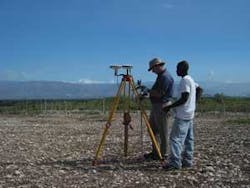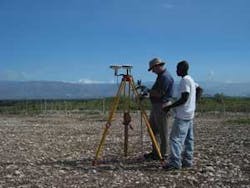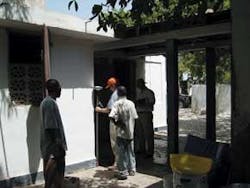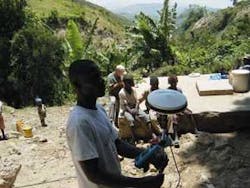GPS helps speed survey work in Haitian water projects
By George Greene IV
Photo by WMI
The use of Global Positioning Survey (GPS) equipment by the non-profit organization Water Missions International (WMI) for mapping and navigating potential project areas in Haiti has resulted in significant time savings and lower overall project costs.
Non-profit organizations are often faced with tight funding situations and are constantly looking for ways to do more with fewer resources. Each project WMI considers entails a thorough site evaluation, which means visiting the site and gathering all relevant information about current water problems and available resources. Project engineers must use this information to develop a feasible solution to the problems and then put together a plan and a cost estimate.
Until WMI acquired the ProMark2 GPS unit from Thales Navigation of Santa Clara, California, USA, engineers performed site evaluations in two phases, with each phase involving a separate trip to the site - typically a difficult and expensive undertaking, given their remote location. The first phase determines whether the project was viable - that is, whether a practical solution could be reached based on available water resources and funding. Project engineers returned on a second trip to gather more information and survey the site if the project was viable.
Since WMI began using ProMark2 in August 2003, the equipment has eliminated the need for second trips for projects by incorporating the entire survey into the initial visit. The reason, of course, is speed. Unlike the old line-of sight survey equipment used by WMI, the ProMark2 includes two receivers that can be set up quickly and operated by a single person. Its Stop and Go survey mode enables surveyors to check data as they work. One receiver is fixed as a base station while the other, called the rover, is used to collect relevant data points. The data from the base station is then used to correct the error in the GPS data received by the rover. Once the base station is set up, the rover can collect data anywhere within a 25-kilometre radius and achieve centimetre-level accuracy relative to the base station.
Accuracy is critical in site surveys. Distances between points and elevation changes are all part of cost estimate calculations, taking into account piping requirements or the need for pumps or towers to overcome pressure drops, for instance.
ProMark2 is small, lightweight and affordable for a professional system, offering high-quality results at the lowest cost - under US$ 4,000 for a two-receiver configuration with software. In addition, the ProMark2 delivers a combination of post-processed, centimetre-level static survey capabilities with stand-alone, real-time, sub-three-meter reconnaissance, navigation and mapping capabilities in a single system.
Photo by WMI
The navigation capability of the ProMark 2 particularly comes in handy in remote regions where one can easily get lost. Project engineers can automatically track their route and mark waypoints, so their return trip home is available as a reverse route with directions, bearings and an estimated time of arrival (ETA).
WMI gave the ProMark2 its first workout in site evaluations at six locations in Haiti last August. The ProMark2 is so easy to use that even those with no formal survey training are able to operate it with only a little instruction. The Piper Cherokee pilot, who flew WMI staff into Haiti for the project, began using the ProMark2 at the third site visited. The sites were situated in densely populated areas on the outskirts of Port-au-Prince, in many cases consisting of compounds housing churches, schools and community buildings. The sites had various, typically inadequate, potable-water supplies, and in most cases, waste water dumped directly into holes in the ground was seriously contaminating such drinking water sources as did exist. The Rotary Clubs of South Carolina (USA) are funding the projects.
The site evaluations produced a number of recommendations, from drilling deep wells to disinfecting and distributing existing supplies from springs and other sources. Project engineers also proposed solar-powered pumps for some sites, a technology requiring a significant initial investment, but one that tends to be sustainable and requires little in the way of maintenance and operating expense. Sustainability is a key requirement for all sites, since reliable maintenance is difficult to guarantee and equipment that breaks down often remains unrepaired.
Various types of wastewater treatment systems, from septic tanks and drain fields to oxidation ponds, were proposed. At many of the sites, WMI also recommended elevated storage tanks to provide water during the communities' frequent and regular power outages. The six water systems - at Croix-des-Bouquets, Crochu, Fond Parisien, Gorman, Lilavois and Thomazeau - are designed to provide some 40,000 gallons of potable water to about 6,000 people a day.
Project engineers checked their site survey data by interfacing the ProMark2 with a laptop PC in the field to create maps, which act essentially as blueprints for the overall project. The speed of the GPS technology shortened the project - originally budgeted for seven days in the field for survey work - down to five.
Nearly all the non-profit organisation's income is from charitable sources, and its management efficiently accounts for all expenses and economises wherever possible. Its tax-exempt status and volunteerism helps significantly in completing more water projects with fewer resources. So the effort invested in research and development of cost-effective technologies, such as the ProMark2 and GPS technology, in the water field resulted in important savings.
Author's Note
George Greene IV is a process engineer with Water Missions International www.watermissions.org, headquartered in Charleston, South Carolina, USA.
WMI is a Christian non-profit organisation dedicated to helping solve a variety of water problems in developing countries by custom-designing community systems for water treatment and distribution, wastewater management and stormwater control.
It originated from General Engineering Laboratories, a small environmental consulting firm founded by Molly and George Greene III in Charleston, South Carolina, USA in 1981. That company grew to become one of the top ten environmental testing laboratories in the USA, and one of the largest environmental engineering consulting firms in the US state of South Carolina.
In 1998, General Engineering Laboratories responded to the devastation in Honduras caused by Hurricane Mitch by designing, constructing and delivering six portable water treatment units, each capable of producing safe drinking water at the rate of ten gallons per minute. Within three weeks, 16 company volunteers travelled to remote parts of Honduras setting up water treatment units.
Other projects followed and the Greenes sold General Engineering in 2001 and used proceeds from the sale to establish Water Missions International. The organization is currently involved in projects in Ecuador, Haiti, Honduras, Mexico and Uganda, and recently teamed with FedEx, the Southern Baptist Convention, International Aid and the US Department of Defense to provide portable water treatment units to war-torn areas in Iraq.




